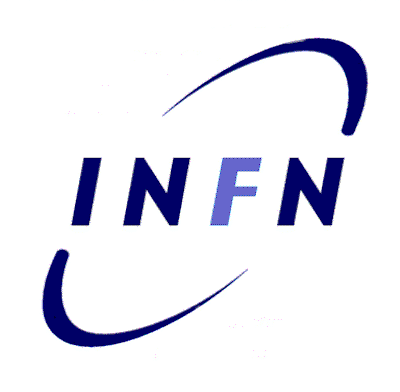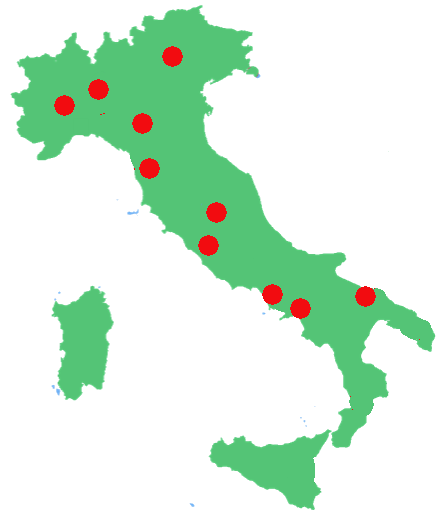Scientific activities of the various Research Units
Bari
-
The main activities of the Bari group are:
- Development of algorithms for the inference of causal relationships among variables; application to the estimate of brain directed functional connectivity.
- Study of the relation between brain function and structure.
- Modeling of macromolecules of biological, medical and technological relevance, through different theoretical methods: coarse grained models, all-atoms molecular dynamics simulations and density functional theory.
- Stochastic Gompertzian growth of biological organisms and Levy processes.
- Renormalization of Shannon entropy of continuous and discrete laws.
- Dynamics of stochastic bridges for Markov processes backward in time.
Milano
-
The Milano node focuses on the study of different fields of theoretical biophysics, such as protein folding, with particular emphasis on the denatured state of proteins, protein
aggregation, molecular evolution, genetic networks, structure of eukariotic chromatin and the neural reprentation of space in mammalians. All these activities are carried out in close
contact with experimental groups, and are guided by the idea of developing simplified models strictly based on experimental data. The methods come from the realm of statistical
mechanics, making heavy use of computational tools.
Napoli
-
We work on the Statistical Mechanics of Complex Systems in Physics and its
applications to Life Sciences. Our research background includes
equilibrium and off-equilibrium critical phenomena, disordered and glassy
systems, spin glasses, and granular media. In particular, at the frontier
between Physics and Molecular Biology, we investigate the molecular
mechanisms underlying genome regulation in eukaryotes, by combining their
Statistical Physics description, computer simulations, and high-throughput
data analysis.
Parma
-
The activity of the Parma Unit covers topics related to equilibrium and non equilibrium statistical mechanics approaches to biological systems, with a particular focus on graphs and
complex network. The main research themes have covered areas ranging from chemical kinetics and reaction diffusion processes in confined geometries, to idiotypic networks, to neural
networks theory, to application of entropic distances to the evolution of biological sequences.
Some recent results: - An analysis of the evolution of the influenza virus H3N2 and H1N1, based on an entropic metric that seems to be able to trace the main characteristic on emerging viral strain. - a complex network approach to the partial synchronous regimes of neural networks LIF models with short term synaptic plasticity.
Perugia
-
The activity of the Perugia unit will mainly concern the development of analytical
methods to effectively construct complex biopolymer conformations and
mechanical properties, such as the typical helix folded structure of a large variety of
peptides and nucleic acids. Such methods will exploit recent techniques developed in
the context of mathematical physics and will require, to some extent, an ad hoc
parametrization issuing from atomistic simulations rooted into quantum mechanical and
molecular dynamics approaches. On this part of the project it is planned to continue the
already on-going fruitful collaboration with the Pisa unit.
Pisa
-
The activity of the Pisa group is focused on the developments and applications of methodologies
for simulating complex biological systems. We currently develop integrated multiscale approaches
rooted into first-principle calculations, tight-binding methods, molecular dynamics techniques and
non-periodic boundary conditions, that make feasible the accurate treatment of structural, dynamic
and thermodynamic properties of biological macromolecules in their natural environment. Among others,
our group is investigating the ionic translocation through protein channels, the dynamics of lipid
membranes, the optical properties of molecular probes for imaging studies, the dynamics of alpha,alpha
dialkylated peptides, and the solvation via polarizable models.
Roma 2 "Tor Vergata"
-
The Tor Vergata Biophysics group is presently mainly focused on the study of protein aggregation phenomenon in the presence of metals dwelling on a synergistic use of quantum-mechanical
simulations to understand the recently available synchrotron- and Free Electron Laser-based XAS and XRD data. Metals are in fact generally believed to play an important role in the
misfolding and aggregation phenomena that lead to the development of neurodegenerative diseases.
The group recently demonstrated by XAS measurements the competition between Cu(II) and Zn(II) ions for Prion-protein tetra-octarepeat peptides binding, suggesting a role of the protein
in the more general context of metal homeostasis.
Salerno
-
The research activity of our group focus on dynamics of the neural cortical area, in particular analysis
of spontaneous activity in neuronal networks, spatio-temporal correlations in signals of brain activity,
learning and memory performances of neuronal networks.
Another topic of our research activity is modelling the spreading of infectious diseases, by using statistical mechanics techniques in order to reconstruct the dynamical contact network of individuals.
Torino
-
The activity of the Torino unit is focused in three directions:
-
1) Protein Translocation.
The process of translocation of proteins and other biopolymers across cellular membranes is crucial for all living organisms. In this context we study in particular a coarse-grained Ising-like Go model of protein folding, often referred to as Wako- Saito-Munoz-Eaton model. -
2) Signaling Networks.
In particular we study the self-organizing dynamics of signaling domains and of complex tissues organization by combining statistical physics methods and biological experiments. -
3) Gene Regulation.
In particular we study the so called network motifs: small systems composed by a few regulatory units which are able to perform simple regulatory functions.
TIFPA - Trento
-
The research activity of the Trento group focuses on the study of the non-equilibrium dynamics of classical and quantum excitations inside biomolecular systems. In this context, we
develop and apply theoretical/computational enhanced sampling methods to investigate in atomistic detail rare conformational reactions, such as e.g. protein folding and mis-folding. We
also develop non-equilibrium quantum
field theory methods to study the transport of charged
and neutral quantum excitations of the molecule electronic structure, in organic polymers
and biological compounds.
^ Back to Top


